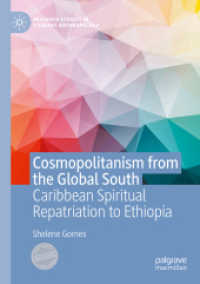- ホーム
- > 洋書
- > ドイツ書
- > Humanities, Arts & Music
- > Linguistics
- > romanic linguistics
Full Description
The works of Giorgio Scerbanenco repeatedly articulate and explore the implications of new forms of criminality that emerged in Italy's post-war transformation towards its «economic miracle». An indepth analysis of Scerbanenco's Duca Lamberti series constitutes the critical focus of this study, and in particular the psychological resonances of the role played by the author's controversial representation of the urban space, its violence, (in)justice and gender roles. In what way do these elements heighten and/or exaggerate the nature of the criminal acts and the reader's experience? This study therefore investigates a reader's potential response to the content, the settings, and, above all, the characters Scerbanenco portrays in these four novels.
Contents
Contents: Cecilia Scerbanenco: Preface - Introduction: Crime Fiction and the Question of Literary Genre - Italian Crime Fiction from its Origins to the 1960s - Giorgio Scerbanenco: From giallo to noir - The Arthur Jelling series - Evolution of Crime in Italy's Post-war Period - Urban Environments and Crime: Criminal Metamorphoses in the Urban Space Urban Space through Symbols - Violence, Justice and Moral (Dis)Orientation: Violence as a Principle for Moral Evaluation - Moral (Dis)Orientation: The Justifiable Act of Violence - Female Characters and Gender Identity: Controlled Unconventional Female Characters - The Economic Miracle: a Collective Cultural Trauma.








